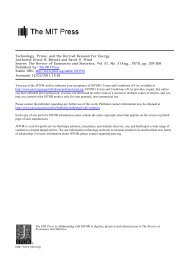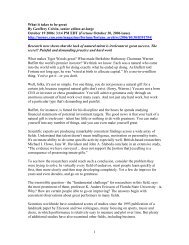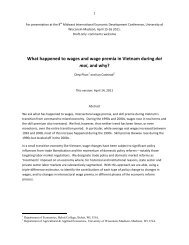Capital-Labor Substitution and Economic Efficiency Author(s): K. J. ...
Capital-Labor Substitution and Economic Efficiency Author(s): K. J. ...
Capital-Labor Substitution and Economic Efficiency Author(s): K. J. ...
Create successful ePaper yourself
Turn your PDF publications into a flip-book with our unique Google optimized e-Paper software.
CAPITAL-LABOR SUBSTITUTION AND ECONOMIC EFFICIENCY 227<br />
course, considerable variation in the composi-<br />
tion of output within a given industrial category<br />
among countries at different income levels,<br />
which cannot be allowed for here.<br />
<strong>Labor</strong> inputs <strong>and</strong> costs. <strong>Labor</strong> inputs are<br />
measured in man-years per $iooo of value add-<br />
ed. They include production workers, salaried<br />
employees, <strong>and</strong> working proprietors. <strong>Labor</strong><br />
costs are measured by the average annual wage<br />
payment, computed as the total wage bill divid-<br />
ed by the number of employees. The data on<br />
wage payments for different countries include<br />
varying proportions of non-wage benefits, <strong>and</strong><br />
we made no allowance for such variations. The<br />
data on employment are not corrected for inter-<br />
country differences in the number of hours<br />
worked per year or the age <strong>and</strong> sex composition<br />
of the labor force. The data for each industry<br />
are given in the appendix.<br />
EIxchange rates. All conversions from local<br />
currency values into U.S. dollars were at official<br />
exchange rates or at free market rates where<br />
multiple exchange rates prevailed. No allow-<br />
ance was made for the variation in the purchas-<br />
ing power of the dollar between different cen-<br />
sus years.<br />
TABLE 2. - RESULTS OF REGRESSION ANALYSIS a<br />
<strong>Capital</strong> inputs. Data on capital inputs or<br />
rates of return are available only for a small<br />
number of countries <strong>and</strong> industries. They are<br />
therefore omitted from the initial statistical<br />
analysis <strong>and</strong> utilized in section III to test the<br />
validity of the production function that is pro-<br />
posed in section II.<br />
B. Regression Analysis<br />
The variables available for statistical analy-<br />
sis are as follows:<br />
V : value added in thous<strong>and</strong>s of U.S. dol-<br />
lars<br />
L : labor input in man-years<br />
W : money wage rate (total labor cost di-<br />
vided by L) in dollars per man-year.<br />
As an aid in formulating the regression anal-<br />
ysis, we make the following preliminary assump-<br />
tions, the validity of which will be examined in<br />
section III.<br />
(i) Prices of products <strong>and</strong> material inputs<br />
do not vary systematically with the wage level.<br />
(2) Overvaluation or undervaluation of ex-<br />
change rates is not related to the wage level.<br />
(3) Variation in average plant size does not<br />
affect the factor inputs.<br />
Regression Test of Significance on b<br />
equations St<strong>and</strong>ard Coeff. of<br />
isic error deter. Degrees of Confidence level for<br />
No. Industry Log a b Sb R2 freedom b different from I<br />
202 Dairy products .4I9 .72I .073 .92I I4 99%?<br />
203 Fruit <strong>and</strong> vegetable canning .355 .855 .075 .9IO I2 90<br />
205 Grain <strong>and</strong> mill products .429 .909 .o96 .855 I4 *<br />
206 Bakery products .304 g900 .o65 .927 I4 8o<br />
207 Sugar .43I .78I .JI5 .790 II 90<br />
220 Tobacco *564 .753 .I5I .629 I3 8o<br />
23I Textile - spinning <strong>and</strong> weaving .296 .809 .o68 .892 I6 98<br />
232 Knitting mills .270 .785 .o64 .9I5 I3 99<br />
250 Lumber <strong>and</strong> wood .279 .86o .o66 .9IO i6 95<br />
260 Furniture .226 .894 .042 .952 I4 95<br />
27I Pulp <strong>and</strong> paper .478 .965 .IOI .858 I4 *<br />
280 Printing <strong>and</strong> publishing .284 .868 .056 .940 I4 95<br />
29I Leather finishing .292 .857 .062 .92I I2 95<br />
3II Basic chemicals .460 .83I .070 .898 I4 95<br />
3I2 Fats <strong>and</strong> oils .5I5 .839 .090 .869 12 90<br />
3I9 Miscellaneous chemicals .483 .895 .059 .938 14 90<br />
33I Clay products .273 .9I9 .o98 .878 II<br />
332 Glass .285 .999 .o84 .92I II *<br />
333 Ceramics .2IO .90I .044 .974 IO 95<br />
334 Cement .560 .920 .I49 .770 IO<br />
34I Iron <strong>and</strong> steel .363 .8II .05I .936 II 99<br />
342 Non-ferrous metals .370 I.OII .J20 .886 8 *<br />
350 Metal products .30I .902 .o88 .897 II *<br />
370 Electric machinery .344 .870 .ii8 .804 I2 *<br />
a From data given in the Appendix.<br />
* Not significant at 8o% or higher levels of confidence.







